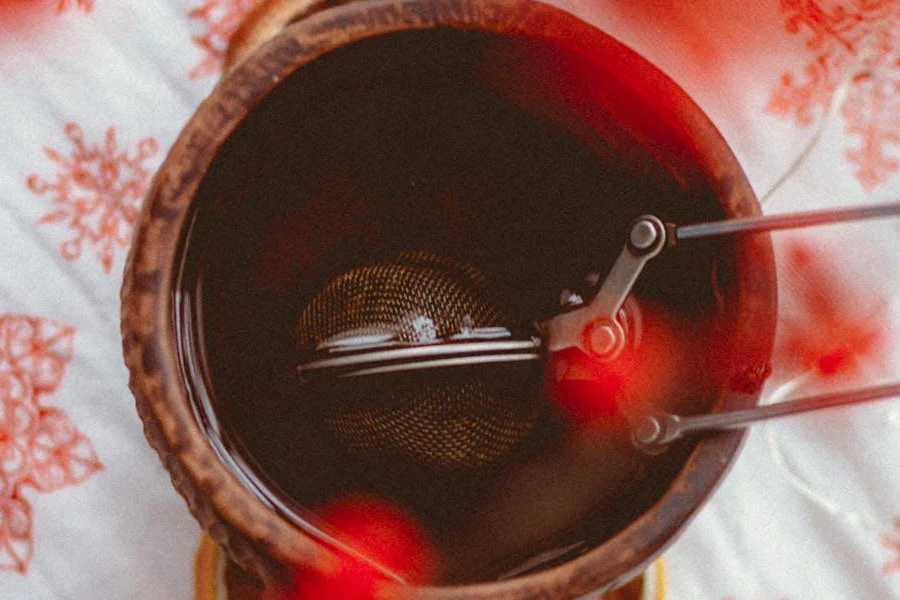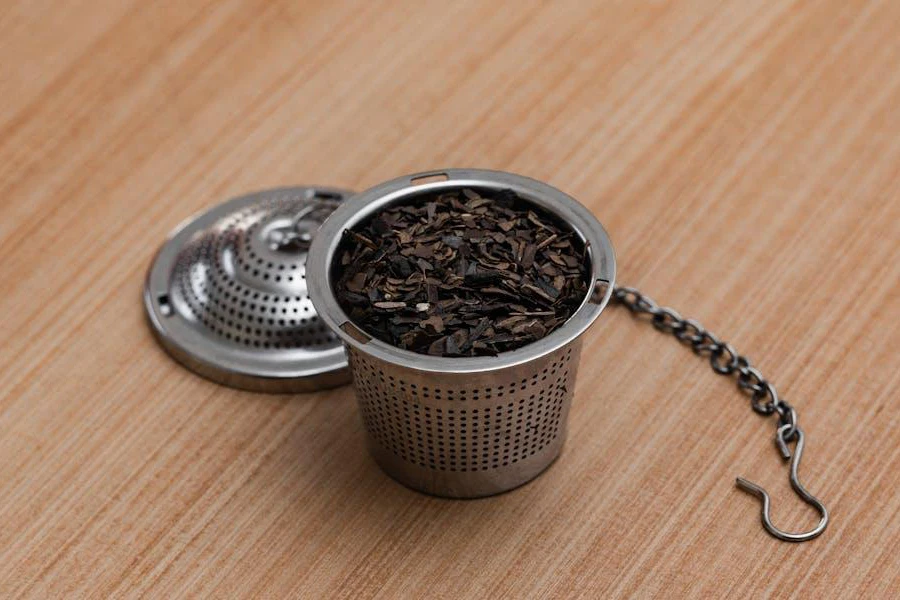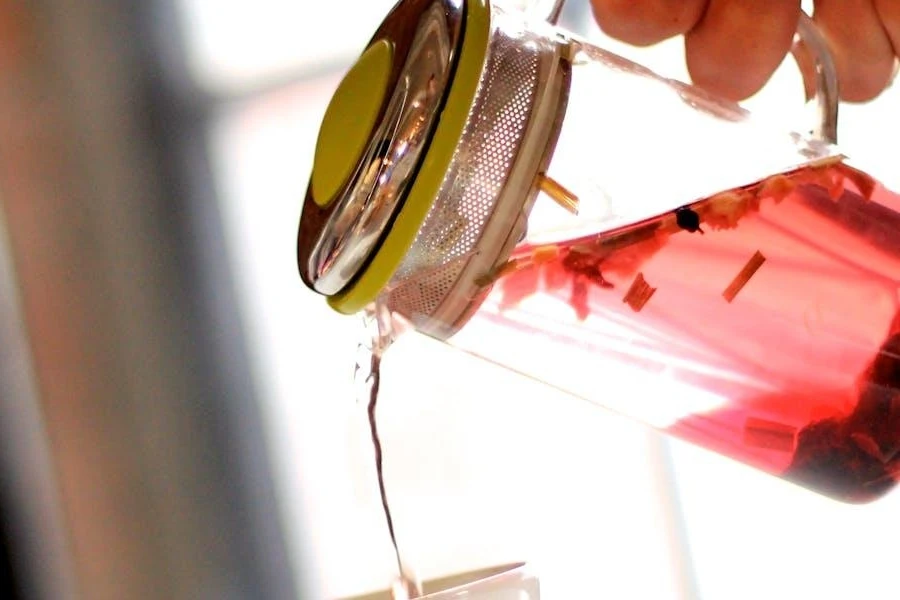Tea infusers became a big deal because many people love and live for loose-leaf tea. Since 2700 BC, it has been a big deal. Originating from China, tea infusers have become a global phenomenon for tea lovers. This means that retailers of tea-related products can plug into this vast targeted niche and opportunity, delivering highly profitable tea infusers in 2024.
Keep reading to find out everything you need to know to select the best tea infusers that will boost your sales and attract loyal consumers.
Table of Contents
Is the tea infuser market profitable in this era?
What are tea infusers and what are their benefits?
Types of tea infusers
Tea infusers: 3 tips to help choose the perfect one
Conclusion
Is the tea infuser market profitable in this era?
Although tea infusers were a big hit two eras back, their market still remains profitable today. Experts valued the global tea infuser market at US$ 5.3 billion in 2023 and expect the growing demand for herbal and fruit teas to boost the market at a 6.0% compound annual growth rate (CAGR). At that rate, the global market would reach US$ 9.6 billion by 2033.
Metal tea infusers (especially stainless steel) recorded the most sales in 2023, although silicone materials are quickly gaining ground and will snatch more market share over the forecast period. Asia Pacific remains the most profitable region for this market, as tea is deeply rooted in the region’s culture.
What are tea infusers and what are their benefits?

The tea industry developed to the point where consumers demanded a better way to brew tea than eco-dangerous tea bags. In the 19th century, tea infusers exploded in popularity and fame as the perfect way to get maximum tea flavors and aromas—and they have stayed around until today for tea enthusiasts.
So, what are tea infusers? They are basically tools designed to hold loose tea leaves for steeping and brewing. Consumers can place them in their tea pots or cups to extract all the tea goodness directly from the leaves without pesky bags. In addition to offering superior flavor, tea infusers are also eco-friendly, as they help eliminate the waste associated with disposable tea bags.
Types of tea infusers
Tea infuser basket

Nothing beats brewing loose-leaf tea or herbal infusion with tea infuser baskets. These baskets allow the tea leaves to unfurl and expand fully when submerged. Their designs also allow water to circulate better around the leaves, extracting maximum flavor and aroma. While great, these baskets are popular because they can handle many tea types, from delicate white to bold black teas—even herbal blends.
Tea infuser baskets also give consumers complete control over the quantity of tea leaves used and the steeping time. As a result, consumers can customize their brew’s strength according to their preferences. Plus, they are incredibly easy to use—consumers only need to scoop the tea leaves into the basket and remove them after steeping. They are also easy to clean, with most models being dishwasher-safe or quick to rinse out by hand.
Tea ball infuser

One good thing about tea ball infusers is their simplicity. They are incredibly easy to use, only requiring filling with leaves and submerging in hot water. While these balls can’t handle larger servings, they are perfect for brewing individual cups of tea. Their small size makes them ideal for travel or taking to the office.
But here’s the cool part: tea ball infusers are usually the most affordable way to brew natural leaves. Plus, they come in various sizes and fun shapes, allowing consumers to enjoy some perks while brewing their favorite tea. However, some tea balls, especially smaller ones, may not allow some tea leaves to expand fully, slightly limiting flavor extraction. Sometimes, fine particles may escape into the cup if the mesh design is not fine enough.
Silicone tea infuser
Tea brewing doesn’t have to be boring, and manufacturers made silicone tea infusers to prove exactly that. These tea infusers come in a massive variety of shapes and colors—animals, fruits, geometric designs, name it! This unconventional design adds a touch of playfulness to the average tea ritual.
Silicone is also flexible enough to make these tea infusers easy to fill, empty, and clean. Even better, silicone tea infusers are heatproof, so consumers can safely steep their tea without worrying about them melting or leaching chemicals—no imparting unwanted flavors or odors here!
Infuser teapots
While regular infusers are great, they only handle the brewing aspect of tea making. However, infuser teapots take things further by combining the brewing and serving process into one vessel. They have built-in infusers that let consumers prepare the tea and serve it directly from the pot.
Infuser teapots are the go-to for consumers brewing for multiple people or who want to enjoy several cups in a sitting. They are also visually appealing, with many infuser teapots (especially glass ones) allowing consumers to watch the leaves unfurl and the water change color as the tea steeps.
Travel mugs with built-in infusers

What if consumers want to enjoy tea on the go without carrying a separate infuser? They can go for travel mugs with built-in infusers. These accessories are perfect for work, school, or any situation where consumers want to enjoy quality tea without the hassle of carrying multiple items.
The amazing part is that most travel mugs are insulated, meaning they can keep tea hot (or cold) for an extended period. While designed for tea, consumers can also use many of these mugs for regular coffee or water. However, they may be trickier to clean than standard mugs, especially those with detailed infuser designs.
Tea infusers: 3 tips to help choose the perfect one
Type of tea consumers enjoy
Choosing tea infusers goes deeper than selecting based on preferences. Consumers often choose their perfect infuser type based on the tea they enjoy the most. Why can’t all tea infusers handle all tea types? It’s not that they can’t brew different tea types, but each design handles it differently—don’t forget tea types have varying leaf sizes and shapes, so one design may not work well for certain types.
For instance, whole-leaf teas, like white tea or some oolongs, require enough room for expansion. That’s how they release their full flavor and aroma for maximum enjoyment. For this reason, tight infusers (like some tea balls) will not draw out their full potential. Such infusers may restrict water flow and limit proper steeping.
Similarly, smaller, broken-leaf teas or teas with many fine particles (like some black teas or herbal blends) need infusers with finer mesh to prevent them from escaping into the cup. Material is also important, as some tea types are sensitive to lingering flavors or staining.
Infuser material
As mentioned above, material is another core consideration when choosing tea infusers. Some tea types don’t mix well with certain materials and ruin the entire process for most tea enthusiasts. This section will examine some more common infuser materials, including stainless steel, silicone, glass, and nylon/plastic.
Stainless steel infusers are like die-hard companions. They are durable enough to last years and highly resistant to rust and wear. Stainless steel infusers also come in various mesh grades to suit different tea types, making them one of the most versatile options. More importantly, these infusers are flavor-neutral, meaning they won’t impart any unnatural tastes to the tea. However, some users report a slight metallic taste with certain teas, especially at higher brewing temperatures.
As mentioned in the types section, silicone tea infusers are in a league of their own. They come in various shapes and colors to make tea rituals more personalized. But what was not mentioned is that lighter-colored silicone infusers may stain over time with strongly-colored teas (like herbal blends).
Glass is another amazing material that offers a different spin on tea brewing. It’s the perfect material for consumers looking for a more aesthetic way to enjoy their tea ritual because of the clear view. More importantly, glass infusers are flavor-neutral and can easily brew teas at hot temperatures. However, they are more fragile than metal or silicone variants.
While all these materials are great, they can be way beyond some people’s budgets. However, nylon/plastic variants (especially the BPA-free options) offer a more affordable way to brew amazing tea. They are also more common in travel mugs or infusers where weight is a concern. But they are not without their faults—plastic infusers have lower durability and may absorb flavors and stain over time with frequent use.
Size and capacity
Besides accounting for leaf expansion, infuser size determines other areas of the tea brewing experience. For instance, larger infusers allow for more tea leaves, potentially yielding a stronger brew. Conversely, smaller infusers are better for weaker cups. Here’s a table showing the different infuser sizes and capacities.
| Infuser type | Size (diameter or width) | Capacity (teaspoon equivalent) | Ideal teas |
| Tea ball (small) | 1.5 inches | 1-2 teaspoons | Fine-leaf black teas and herbal blends. |
| Tea ball (large) | 2 inches | 2-3 teaspoons | Whole-leaf black teas and oolongs. |
| Basket infuser (small) | 2 to 3 inches | 2-3 teaspoons | Black teas and green teas. |
| Basket infuser (large) | 3+ inches | 4+ teaspoons | Whole-leaf teas (white and oolong) |
| Travel mug infuser | Varies (depends on mug size) | Generally holds 2-3 teaspoons | Individual servings of various teas. |
| Infuser teapot (small) | 12-16 oz | 2-3 tablespoons | Loose leaf teas for 1-2 people |
| Infuser teapot (large) | 32+ oz | 4+ tablespoons | Loose leaf teas for multiple people. |
Conclusion
With tea culture growing rapidly, consumers are searching for eco-friendly and responsible ways to enjoy their favorite beverages. While tea infusers have been around for a really long time, they have recently gained more traction due to the rising trend of healthy tea enthusiasts. Their traditional designs may still be around, but many manufacturers have crafted updates to give them a more modern appeal. This article covers everything sellers need to know before choosing tea infusers to attract part of the 49,500 users searching for them in March 2024.
If you want to explore more topics like this, subscribe to the Home and Garden category to get all the latest updates.



